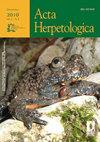Comparative cytogenetics on Zamenis lineatus and Elaphe quatuorlineata (Serpentes: Colubridae)
IF 0.9
4区 生物学
Q4 ZOOLOGY
引用次数: 0
Abstract
Because of their peculiar genomic and chromosomal characteristics, reptiles are extraordinary model organisms to study karyotype and sex chromosome evolution, but despite the growing interest in their evolutionary cytogenetics, only a small fraction of species have a known karyotype. We performed a comparative cytogenetic analysis on Elaphe quatuorlineata and Zamenis lineatus, using classic and molecular techniques. We provide the karyotype of these two species and an assessment of their chromosomal features. Chromosome analysis was performed with standard karyotyping, C-banding, sequential C-banding + CMA3 + DAPI and Ag-NOR staining. On E. quatuorlineata, we also performed CMA3-methyl green staining and Fluorescence in situ Hybridization mapping NOR loci (NOR-FISH). Elaphe quatuorlineata and Z. lineatus show a very similar karyotype of 2n = 36, with 8 macro- and 10 microchromosome pairs, but differ in the morphology of the pair 8, which resulted submetacentric in the former and metacentric in the latter species. By comparing our data to those available from the literature on congeneric species, we analysed the occurrence of primitive and derivate chromosomal characters and provide cytotaxonomic insights, which further support the species status of Z. lineatus. In both species, the 4th pair was identified as the sex chromosome pair (ZZ/ZW) and NORs were localized on a microchromosome pair. We finally highlight in both genera Elaphe and Zamenis different stages of heterochromatinization of the W chromosome, in agreement with the progressive diversification model of sex chromosome as already shown in different reptile taxa.Zamenis lineatus和Elaphe quatorlineata的比较细胞遗传学
由于其独特的基因组和染色体特征,爬行动物是研究核型和性染色体进化的非凡模式生物,但尽管人们对其进化细胞遗传学越来越感兴趣,但只有一小部分物种具有已知的核型。我们使用经典和分子技术对四氏Elaphe quatourlinata和Zamenis lineatus进行了比较细胞遗传学分析。我们提供了这两个物种的核型及其染色体特征的评估。染色体分析采用标准核型、C带、连续C带+CMA3+DAPI和Ag-NOR染色。在E.quatuorineata上,我们还进行了CMA3甲基绿染色和荧光原位杂交定位NOR基因座(NOR-FISH)。Elaphe quatourlineata和Z.lineatus的核型非常相似,2n=36,有8对大染色体和10对微染色体,但对8的形态不同,这导致前者为亚中心,后者为中心。通过将我们的数据与同类文献中的数据进行比较,我们分析了原始和衍生染色体特征的发生,并提供了细胞分类学的见解,这进一步支持了直纹Z.lineatus的物种地位。在这两个物种中,第4对被鉴定为性染色体对(ZZ/ZW),NORs定位在微染色体对上。最后,我们强调了Elaphe属和Zamenis属W染色体异染色质化的不同阶段,这与不同爬行动物类群中已经显示的性染色体的渐进多样化模型一致。
本文章由计算机程序翻译,如有差异,请以英文原文为准。
求助全文
约1分钟内获得全文
求助全文
来源期刊

Acta Herpetologica
ZOOLOGY-
CiteScore
1.20
自引率
12.50%
发文量
10
审稿时长
6 months
期刊介绍:
Acta Herpetologica, a journal open to academics all over the world, offers itself as a new site for the presentation and discussion of the most recent results in the field of research on Amphibians and Reptiles, both living and extinct. The official journal of the Societas Herpetologica Italica (S.H.I.), Acta Herpetologica publishes original works – extended articles, short notes and book reviews – mostly in English, dealing with the biology and diversity of Amphibians and Reptiles.
 求助内容:
求助内容: 应助结果提醒方式:
应助结果提醒方式:


